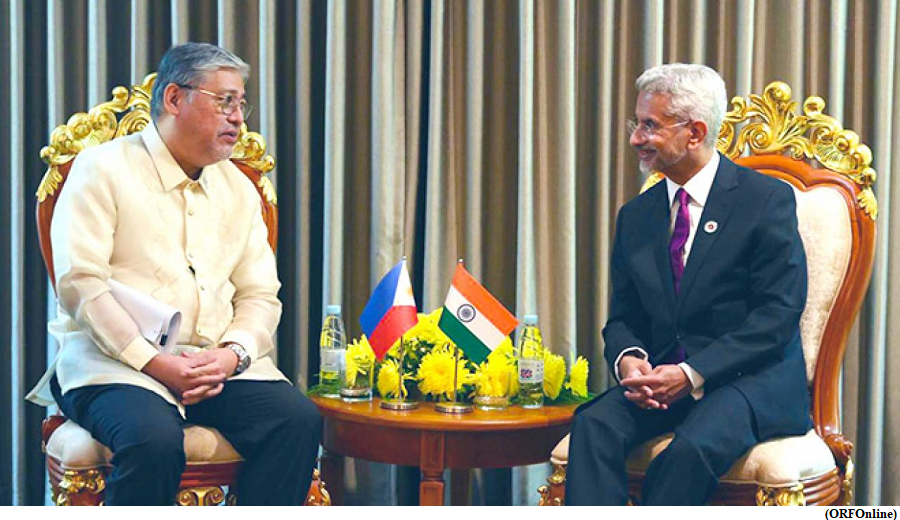Evolving contours of Delhi-Manila ties (GS Paper 2, International Relation)

Context:
- Recently, the Philippine Foreign Affairs Secretary, Enrique Manalo, visited India upon the invitation of External Affairs Minister S. Jaishankar.
- While his visit is aimed at reviewing and enhancing the status of the Philippine-India bilateral partnership, it also comes against the backdrop of an intensifying regional geopolitical landscape.
Indo- Philippines Relation:
- Since, the beginning of the 21st century, the relationship between Manila and New Delhi remained cordial at best despite the conducive strategic environment they both operated in.
- The problem, however, centred on the lack of attention at the domestic decision-making level.
- Among the Southeast Asian countries, the Philippines was not able to significantly operationalise the idea of establishing close strategic ties with India during this period.
- This can be partly explained by the domestic perception of Manila’s leadership between 2001 and 2016, which steered clear of pushing for the diversification of strategic partnerships beyond traditional and immediate relations.
Act East Policy of 2014:
- Since 2016, ties between both the Philippines and India received a much-needed boost due to former President Rodrigo Duterte’s desire to prioritise the diversification of Manila’s strategic partners, particularly in the realm of security.
- This coincided greatly with the notable developments spearheaded by Indain Prime Minister towards Southeast Asia through the Act East Policy of 2014.
- The period saw a series of important milestones, such as regular high-level visits between the senior officials of both countries, a first-ever quadrilateral joint naval exercise in the South China Sea in 2019, with the inclusion of the US and Japan, and the sale of the BrahMos supersonic cruise missiles in 2022.
- It was also during this period when India provided US $500,000 to the Philippines amidst the devastating siege in Marawi in 2017, which was the first time ever India provided any country with aid, directed towards counterterrorism efforts.
- Moreover, in 2020, the Philippine Navy flag officer in command Vice Admiral Giovanni Carlo Bacordo highlighted how the expansion of naval cooperation with India is crucial to keep the “seas safer and more secured for everyone”.
Philippine’s Defence Cooperation:
- In a bid to prioritise Philippine territorial defence and maritime security, Marcos Jr. has been intensifying Manila’s security engagements with its traditional ally, the US.
- From the expansion of the Enhanced Defence Cooperation Agreement (EDCA) to the establishment of a framework for joint maritime patrols in the South China Sea, the Philippines and the US are continuously endeavouring to deepen and broaden the scope of their partnership.
- This eventually resulted in the inauguration of trilateral sea drills with Japan and a potential quad-like arrangement with Australia, which has the potential of narrowing the operational gaps within the US hub-and-spokes network in the Indo-Pacific for better functionality in securing the established order.
Area-specific cooperative frameworks:
- Amidst this reality, there is an opportunity for Philippine and India to work closely within such an extended multilateral framework.
- While India is a major defence partner of the US, it also shares a global and strategic partnership with Japan and a comprehensive strategic partnership with Australia.
- All four major Indo-Pacific democracies are engaged in various bilateral and multilateral arrangements with the purpose of safeguarding the peace and stability of the Indo-Pacific.
- Therefore, the chances of synergising efforts towards area-specific cooperative frameworks between the Philippines and India in the context of a wider multilateral strategic network with the US, Japan, and Australia are feasible, given that its basic operationalisation was witnessed in 2019. Such activities can be replicated and remodelled in the future given the deep convergences of all countries involved.
China factor:
- While the Philippines has chosen to deepen its alignments with the US hub-and-spokes system, it remains steadfast in maintaining and managing ties with China.
- Philippine President emphasized its desire to enhance its maritime security capabilities is in no way aimed at disengaging and cutting ties with China. Similarly, during his lecture Indian Council of World Affairs (ICWA), he explained how the maritime dispute with China does not define the overarching nature of bilateral ties between Manila and Beijing.
India can serve as a strategic buffer:
- This perspective of Philippines converges well with India’s consistent adherence to strategic autonomy. Being the fifth-largest economy with the world’s largest population and a formidable military, India has opposed engaging in bloc politics; rather, it has constantly pushed for cooperation based on common concerns, interests, and respect for domestic sensitivities.
- While India continues to face tensions with China along the Line of Actual Control (LAC), it keeps diplomatic channels open, along with the emphasis on not taking part in any rigid coalition against a particular country.
- Given this level of political maturity, Philippines will be able to maximise its ties with a rising India without worrying about falling deeper into the US-China power competition.
- Therefore, India can serve as a strategic buffer amidst Philippines desire to manage relations with China on one hand and enhance security ties with the US alliance network on the other.
Way Forward:
- Given this reality, the Philippines and India are faced with an opportunity to maximise the potential of their bilateral partnership.
- Given Philippines limited cyber-defence capabilities, it is crucial for the Southeast Asian country to utilise its security partnerships to further this goal. In this light, India offered operational cyber security training to the Philippines military.
- The Philippines and India also discussed the possible deployment of an Indian defence attaché in Manila, indicating their desire to explore new areas of security cooperation. Therefore, it is imperative for both states to continue maximising the utility of their emerging partnership given the strategic uncertainties plaguing the Indo-Pacific.
- However, consistency remains the most important component in strengthening any form of strategic cooperation. Thus, the need for both countries to maintain consistent engagements is crucial to further deepen and broaden the scope of their burgeoning ties.


